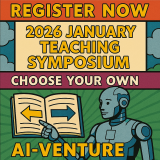
Tips for the Week of March 13, 2023
March 9, 2023
Distracted Students: Are Digital Devices the Real Challenge?
Educators today are quick to blame digital devices for distracting their students and subsequently impose policies banning devices in the classroom. But before we had digital devices, students’ attention drifted out the window, waxed and waned throughout a course or period. James Lang argues, “whenever we are attempting challenging cognitive [or boring] work, distraction sings to us sweetly, beckoning us into easier and more pleasurable pursuits” (Distracted, 2020, p. xiii). The real challenge is to spend more time cultivating attention in the service of meaningful learning. Lang recommends the following five practices:
- Cultivate community in your classroom.
- Build your course around curiosity.
- Change renews attention; structure variety into your weekly activities.
- Embed signature attention activities – focusing, creating, connecting.
- Use low-stakes assessments to help students focus their attention.
Helping Students ‘Get the Picture’
Research on dual coding theory tells us that presenting information both visually and verbally supports students’ ability to retain and recall that information. Additionally, visual elements can encourage interaction, improve learner motivation, and support a more inclusive learning environment. Using visuals that include both textual and graphic information helps reduce cognitive load, and images can be used to illustrate more abstract concepts or supplement understanding of textual information. Learn more about five general types of visual elements and see examples of each here. Tools such as YuJa, Adobe Express, and Padlet can be used to create a wide range of informative and engaging visual elements to support different types of learners.
Inclusive Course Design: Typical Test Questions
To calm student nerves prior to an upcoming assessment, Hogan and Sathy (2022) suggest providing typical test questions (TTQ) during class. TTQs provide students an opportunity to practice and understand the type and difficulty of questions seen on the upcoming assessment, which can be a barometer to show each student how prepared they are for the assessment. Seeing these questions may be a ‘wake-up call’ for struggling students, who can be invited to seek additional help during office hours. In addition, the instructor can use TTQs to assess students’ learning to determine whether any modifications or adjustments need to be made to the upcoming assessment if most students did not fully understand the concept(s) covered in the TTQ. This video provides a demonstration of how this practice can be implemented.
Interested in exploring any of these ideas further or discussing how you might implement them in your own teaching practices? Contact CETL or schedule a consultation to continue the conversation.
